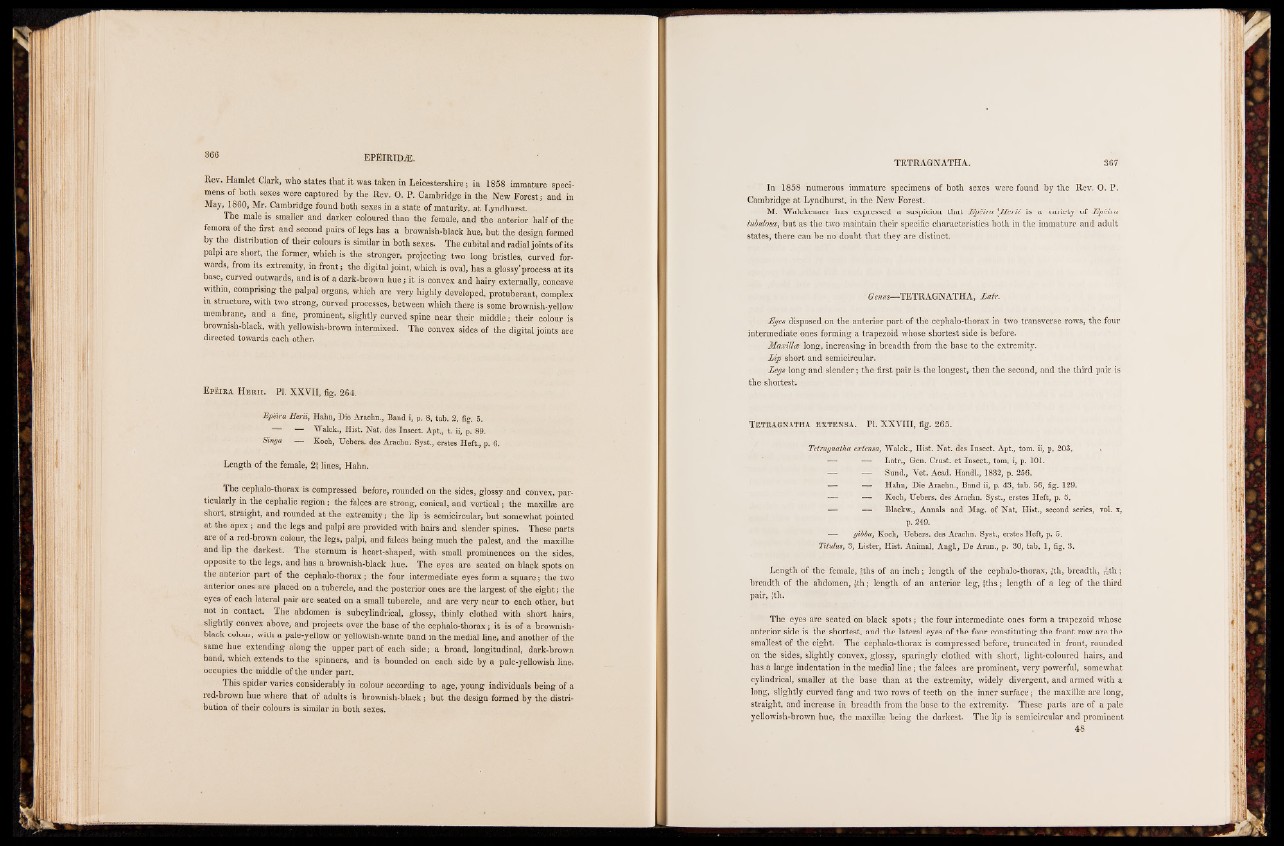
Rev. Hamlet Clark, who states thatjt was taken in Leicestershire; in 1858 immature specimens
of both sexes were captured by the Rev. 0 . P. Cambridge in the New Forest; and in;
May, 1860* Mr. Cambridge found both sexes in a state of maturity, at Lyndhurst.
The male is smaller and darker coloured than the female, and the anterior half of the
femora of the first and second pairs of legs has a brownish-black hue, but the design formed
by the distribution of their colours is similar in both sexes. The cubital and radial joints of its
palpi are short, the former, which is the stronger, projecting two long bristles, curved forwards,
from its extremity, in front; the digital joint, which is oval, has a glossy'process at its
base, curved outwards, and is of a dark-brown hue; it is convex and hairy externally, concave
within, comprising the palpal organs, which are very highly developed, protuberant, complex
in structure, with two strong, curved processes, between which there is some brownish-yellow
membrane, and a fine, prominent, slightly curved spine near their middle; their colour is
brownish-black, with yellowish-brown intermixed. The convex sides of the digital joints are
directed towards each other.
Epeira Herit. PI. XXVII, fig. 264.
Epeira Herii, Hahn, Die Arachn., Band i, p. 8, tab. 2, fig. 5.
— Walck., Hist. Nat. des Insect. Apt., t. ii, p. 89.
Singa Koch, Uebers. des Arachn. Syst., erstes Heft., p. 6.
Length of the female, 2 | lines, Hahn.
The cephalo-thorax is compressed before, rounded on the sides, glossy and convex, particularly
in the cephalic region; the falces are strong, conical, and vertical; the maxillae are
short, straight, and rounded at the extremity; the lip is semicircular, but somewhat pointed
at the apex; and the legs and palpi are provided with hairs and slender spines. These parts
are of a red-brown colour, the legs, palpi, and falces being much the palest, and the maxillae
and lip the darkest. The sternum is heart-shaped, with small prominences on the sides,
opposite to the legs, and has a brownish-black hue. The eyes are seated on black spots on
the anterior part of the cephalo-thorax; the four intermediate eyes form a square; the two
anterior ones are placed on a tubercle, and the posterior ones are the largest of the eight; the
eyes of each lateral pair are seated on a small tubercle, and are very near to each other, but
not in contact. The abdomen is subcylindrical, glossy, thinly clothed with short hairs,
slightly convex above, and projects over the base of the cephalo-thorax; it is of a brownish-
black colour, with a pale-yellow or yellowish-white band in the. medial line, and another of the
same hue extending along the upper part of each side; a broad, longitudinal, dark-brown
band, which extends to the spinners, and is bounded on each side by a pale-yellowish line»
occupies the middle of the under part.
This spider varies considerably in colour according to age, young individuals being of a
red-brown hue where that of adults is brownish-black; but the design formed by the distribution
of their colours is similar in both sexes.
In 1858 numerous immature specimens of both sexes were found by the Rev. O. P.
Cambridge at Lyndhurst, in the New Forest.
M. Walckenaer has expressed a suspicion that Epeira \Herii is a variety of Epeira
tubulosa, but as the two maintain their specific characteristics both in the immature and adult
states, there can be no doubt that they are distinct.
Genus—TETRAGNATHA, Latr.
Eyes disposed on the anterior part of the cephalo-thorax in two transverse rows, the four
intermediate ones forming a trapezoid whose shortest side is before.
Maxillce long, increasing in breadth from the base to the extremity.
Lip short and semicircular.
Leys long and slender ; the first pair is the longest, then the second, and the third pair is
the shortest.
TETRAGNATHA EXTENSA. PI. XXVIII, fig. 265.
Tetragnatha externa, Walck., Hist. Nat. des Insect. Apt., tom. ii, p. 203. »
— — Latr., Gen. Crust, et Insect., tom. i, p. 101.
Sund., Vet. Acad. Handl., 1832, p. 256.
— — Hahn, Die Arachn., Band ii, p. 43, tab. 56, fig. 129.
— — Koch, Uebers. des Arachn. Syst., erstes Heft, p. 5.
— — Blackw., Annals and Mag. of Nat. Hist., second series, vol. x,
p. 249.
— gibba, Koch, Uebers. des Arachn. Syst., erstes Heft, p. 5.
Titulus, 3, Lister, Hist. Animal. Angl., De Aran., p. 30, tab. 1, fig. 3.
Length of the female, fths of an in ch ; length of the cephalo-thorax, 5th, breadth, ^ th ;
breadth of the abdomen, |th ; length of an anterior leg, fth s; length of a leg of the third
pair, ,th.
The eyes are seated on black spots; the four intermediate ones form a trapezoid whose
anterior side is the shortest, and the lateral eyes of the four constituting the front row are the
smallest of the eight. The cephalo-thorax is compressed before, truncated in front, rounded
on the sides, slightly convex, glossy, sparingly clothed with short, light-coloured hairs, and
has a large indentation in the medial line; the falces are prominent, very powerful, somewhat
cylindrical, smaller at the base than at the extremity, widely divergent, and armed with a
long, slightly curved fang and two rows of teeth on the inner surface; the maxillae are long,
straight, and increase in breadth from the base to the extremity. These parts are of a pale
yellowish-brown hue, the maxillae being the darkest. The lip is semicircular and prominent
48